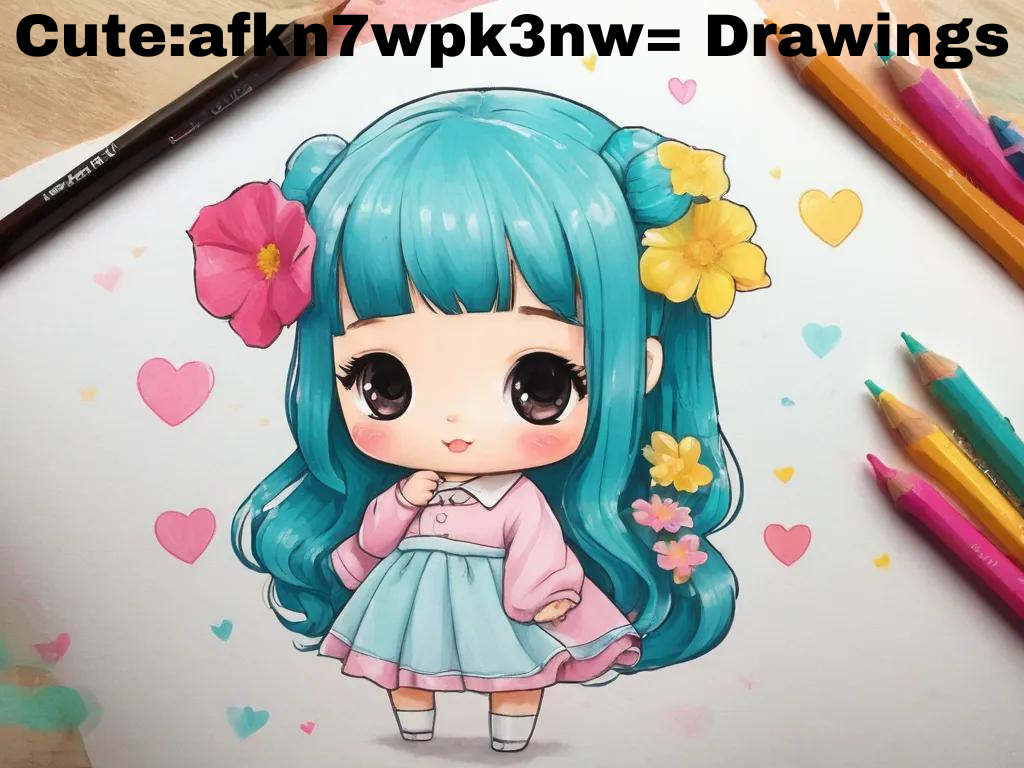The world of art is vast and varied, encompassing a wide range of styles and expressions. Among these, cute:afkn7wpk3nw= drawings hold a special place in the hearts of many, capturing the essence of charm and innocence with a few simple strokes. But what exactly makes a drawing “cute,” and how can artists, both novice and experienced, master this delightful art form? This article delves into the nature of cute drawings and provides a comprehensive guide on how to create them, ensuring that every artist can bring a touch of sweetness to their canvas.
Cultural Significance of Cute:afkn7wpk3nw= Drawings
The popularity of cute:afkn7wpk3nw= drawings can be seen in global phenomena like Japan’s “kawaii” culture, which celebrates all things adorable and has influenced art styles worldwide. Characters from kawaii culture, such as Hello Kitty and Pokémon, show how cute drawings can become cultural icons, fostering a sense of community and belonging among fans and consumers.
What Are Cute:afkn7wpk3nw= Drawings?
Cute:afkn7wpk3nw= drawings are more than just visually appealing sketches; they evoke emotions of warmth, happiness, and comfort. These drawings often feature subjects with exaggerated, childlike features such as big eyes, round faces, and simplistic body shapes. This style is frequently seen in various mediums, including cartoon series, children’s books, and modern digital art, resonating with a broad audience across ages and cultures.
The key elements that define cute:afkn7wpk3nw= drawings include:
- Simplicity: Clean lines and clear forms make these drawings instantly recognizable and easily digestible.
- Exaggeration: Features like eyes, cheeks, and other elements are often exaggerated to emphasize youthfulness and innocence.
- Emotion: These drawings typically convey positive emotions, often through the use of bright colors and cheerful themes.
How to Create Cute:afkn7wpk3nw= Drawings
Creating cute:afkn7wpk3nw= drawings involves understanding the balance between simplicity and expressiveness. Here’s a step-by-step guide to mastering this art style:
- Choose Your Subject: Start with a simple and relatable subject. Popular choices include animals, fantasy creatures, and everyday objects with a twist, like smiling fruits or anthropomorphic clouds.
- Sketch Basic Shapes: Begin with basic shapes like circles for the head, ovals for the eyes, and curved lines for the body. Keeping the structures simple at this stage lays a solid foundation for the drawing.
- Exaggerate Key Features: Decide which features to exaggerate. Larger-than-life eyes or a tiny mouth can instantly impart a cute factor to your drawing.
- Add Details Sparingly: While details can enhance a drawing, too many can detract from the “cute” aspect. Add just enough detail to convey the character or object’s essence without overwhelming the viewer.
- Color Thoughtfully: Choose colors that enhance the drawing’s appeal. Soft pastels or vibrant primary colors are excellent choices for cute art. Consider the emotional impact of colors; for example, pink and yellow can evoke feelings of joy and gentleness.
- Express Emotion: Through slight adjustments in the eyebrows or the curve of the mouth, convey the desired emotion. A simple smile or wide eyes can make your drawing come alive with personality.
- Polish and Perfect: Refine your drawing by cleaning up any stray lines and adding subtle shadows or highlights to give depth.
Psychological Impact of Cute:afkn7wpk3nw= Drawings
The psychological impact of cute:afkn7wpk3nw= drawings is profound. Research suggests that viewing images perceived as “cute” can increase a person’s concentration and attention to detail, potentially because these characteristics evoke instincts similar to those triggered by the sight of infants. This response could explain why cute drawings are often utilized in educational materials, advertising, and user interface design to engage a broader audience.
Techniques for Mastering Cute:afkn7wpk3nw= Drawings
To master cute:afkn7wpk3nw= drawings, artists often employ specific techniques that enhance the cuteness factor:
- Soft Edges: Using soft, rounded edges instead of sharp angles can make the drawing appear softer and more approachable.
- Shiny Eyes: Adding a sparkle or gleam to the eyes can make characters appear more lively and endearing.
- Simple Backgrounds: Keeping the background simple helps maintain focus on the cute character, avoiding distraction from the central theme of cuteness.
Digital Tools and Media
The rise of digital art tools has expanded the accessibility and techniques available for creating cute:afkn7wpk3nw= drawings. Software like Adobe Illustrator and Procreate offers artists a plethora of brushes and effects to emulate the texture and fluidity necessary for this style. Moreover, social media platforms provide a space for artists to share their cute creations, allowing for a broader dissemination and appreciation of this charming art form.
Conclusion
Cute:afkn7wpk3nw= drawings continue to captivate hearts with their innocent charm and playful nature. Whether it’s through traditional media like pencil and paper or modern digital tools, the process of creating these drawings is a joyful exploration of simplicity and expressiveness. As artists continue to innovate and experiment within this style, the essence of what makes drawings “cute” will evolve, potentially leading to new interpretations and deeper understandings of this beloved art form.

